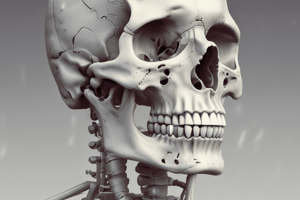Podcast
Questions and Answers
What role do fibroblasts play in the process of fracture repair?
What role do fibroblasts play in the process of fracture repair?
- They transform into osteocytes to strengthen the bone.
- They dissolve dead bone tissue to facilitate healing.
- They fill the fracture gap with blood.
- They secrete collagen fibers to form a connective tissue bridge. (correct)
Which characteristic correctly describes spongy bone compared to compact bone?
Which characteristic correctly describes spongy bone compared to compact bone?
- Spongy bone has a more complex structure with trabeculae. (correct)
- Spongy bone is denser than compact bone.
- Spongy bone contains more blood vessels.
- Spongy bone is primarily found in the outer layers of the bone.
What is primarily found within the Haversian canals?
What is primarily found within the Haversian canals?
- Osteons for structural support.
- Adipose tissue for energy storage.
- Nerves and blood vessels. (correct)
- Collagen fibers and cartilage.
What component distinguishes the bone matrix composition from other connective tissues?
What component distinguishes the bone matrix composition from other connective tissues?
What initial formation occurs during the early stages of bone fracture repair?
What initial formation occurs during the early stages of bone fracture repair?
What role do fibroblasts play in the healing of a bone fracture?
What role do fibroblasts play in the healing of a bone fracture?
Which statement accurately describes the relation between the hematoma and the healing process of bones?
Which statement accurately describes the relation between the hematoma and the healing process of bones?
What is the primary composition of the soft callus that forms after a fracture?
What is the primary composition of the soft callus that forms after a fracture?
In the context of bone restoration, what function do chondroblasts fulfill?
In the context of bone restoration, what function do chondroblasts fulfill?
What type of fracture is characterized by being shattered into multiple fragments?
What type of fracture is characterized by being shattered into multiple fragments?
What is the role of blood vessels in the area of a hematoma in a fractured bone?
What is the role of blood vessels in the area of a hematoma in a fractured bone?
Which fracture results from a twisting force applied to the bone?
Which fracture results from a twisting force applied to the bone?
Which type of fracture is typically associated with the elderly due to reduced bone mass?
Which type of fracture is typically associated with the elderly due to reduced bone mass?
An avulsion fracture commonly occurs in which scenario?
An avulsion fracture commonly occurs in which scenario?
Which type of fracture appears similar to a break in a green twig, involving bending on one side?
Which type of fracture appears similar to a break in a green twig, involving bending on one side?
What type of fracture may interfere with growth and occurs specifically in children and young adults?
What type of fracture may interfere with growth and occurs specifically in children and young adults?
How does a greenstick fracture differ from a complete fracture?
How does a greenstick fracture differ from a complete fracture?
What distinguishes a comminuted fracture from other types?
What distinguishes a comminuted fracture from other types?
Study Notes
Types of Fractures
- Spiral fracture: Caused by twisting forces applied to the bone.
- Compression fracture: Bone crushed under weight bearing, common in elderly and those with reduced bone density.
- Comminuted fracture: Shattered bone into multiple fragments, difficult to repair.
- Avulsion fracture: A tendon or ligament pulls off a fragment of bone, commonly observed in ankle fractures.
- Greenstick fracture: Bone breaks on one side but only bends on the other, similar to a "green" twig. Common in children due to their more flexible bones.
- Epiphyseal plate fracture: Involves at least part of the epiphyseal plate (growth plate), occurs only in children and young adults. May interfere with growth.
Fracture Repair Process
- Stage 1: A hematoma (blood clot) fills the gap between the broken bone fragments.
- Stage 2: Fibroblasts and chondroblasts (cells involved in tissue repair) infiltrate the hematoma, forming a soft callus.
- Stage 3: Fibroblasts secrete collagen fibers, forming a connective tissue bridge that closes the gap between the bone fragments.
Studying That Suits You
Use AI to generate personalized quizzes and flashcards to suit your learning preferences.
Related Documents
Description
This quiz covers the various types of bone fractures, including spiral, compression, and greenstick fractures, as well as the fracture repair process. Understand how different fractures occur and the stages involved in healing them. Perfect for students of anatomy and physiology or those interested in orthopedic medicine.




